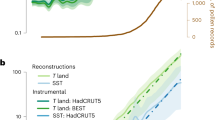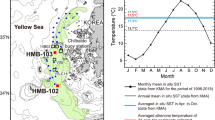Abstract
Considerable climatic variability on decadal to millennial timescales has been documented for the past 11,500 years of interglacial climate1,2,3. This variability has been particularly pronounced at a frequency of about 1,500 years, with repeated cold intervals in the North Atlantic1,3. However, there is growing evidence that these oscillations originate from a cluster of different spectral signatures4, ranging from a 2,500-year cycle throughout the period to a 1,000-year cycle during the earliest millennia. Here we present a reappraisal of high-energy estuarine and coastal sedimentary records from the southern coast of the English Channel, and report evidence for five distinct periods during the Holocene when storminess was enhanced during the past 6,500 years. We find that high storm activity occurred periodically with a frequency of about 1,500 years, closely related to cold and windy periods diagnosed earlier1,2,3. We show that millennial-scale storm extremes in northern Europe are phase-locked with the period of internal ocean variability in the North Atlantic of about 1,500 years4. However, no consistent correlation emerges between spectral maxima in records of storminess and solar irradiation. We conclude that solar activity changes are unlikely to be a primary forcing mechanism of millennial-scale variability in storminess.
This is a preview of subscription content, access via your institution
Access options
Subscribe to this journal
Receive 12 print issues and online access
$259.00 per year
only $21.58 per issue
Buy this article
- Purchase on Springer Link
- Instant access to full article PDF
Prices may be subject to local taxes which are calculated during checkout



Similar content being viewed by others
References
Bond, G. et al. Persistent solar influence on North Atlantic climate during the Holocene. Science 294, 2130–2136 (2001).
Wanner, H. et al. Mid- to late Holocene climate change: An overview. Quat. Sci. Rev. 27, 19–20 (2008).
Wanner, H. et al. Structure and origin of Holocene cold events. Quat. Sci. Rev. 30, 3109–3123 (2011).
Debret, M. et al. Evidence from wavelet analysis for a mid-Holocene transition in global climate forcing. Quat. Sci. Rev. 28, 2675–2688 (2009).
Lamb, H. H. Climatic variations and changes in the wind and ocean circulation. Quat. Res. 11, 1–20 (1979).
Spencer, C. D., Plater, A. J. & Long, A. J. Rapid coastal change during the mid- to late Holocene: The record of barrier estuary sedimentation in the Romney March region, southeast England. Holocene 8, 143–163 (1998).
Pye, K. & Neal, A. The Dynamics and Environmental Context of Aeolian Sedimentary Systems Vol 72, 201–217 (Geol. Soc. Sp. Publ., 1993).
Gilbertson, D. D., Schwenninger, J-L., Kemp, R. A. & Rhodes, E. J. Sand drift and soil formation along an exposed North Atlantic coastline: 14,000 years of diverse geomorphological, climatic and human impacts. J. Arch. Sci. 26, 439–469 (1999).
Wilson, P., McGourty, J. M. & Bateman, M. D. Mid- to late-Holocene coastal dune event stratigraphy for the north coast of Northern Ireland. Holocene 14, 406–416 (2004).
Jelgersma, S., Stive, M. J. F. & van der Valk, L. Holocene storm surge signatures in the coastal dunes of the western Netherlands. Mar. Geol. 125, 95–110 (1995).
Clemmensen, L. B., Murray, A., Heinemeier, J. & de Jong, R. The evolution of Holocene coastal dune fields, Jutland, Denmark: A record of climate change over the past 5000 years. Geomorphology 105, 303–313 (2009).
De Jong, R., Björck, S., Björkman, L. & Clemmensen, L. B. Storminess variation during the last 6500 years reconstructed from an ombotrophic peat bog in Halland, southwest Sweden. J. Quat. Sci. 21, 905–919 (2006).
Sorrel, P., Tessier, B., Demory, F., Delsinne, N. & Mouazé, D. Evidence for millennial-scale climatic events in the sedimentary infilling of a macrotidal estuarine system, the Seine estuary (NW France). Quat. Sci. Rev. 28, 499–516 (2009).
Billeaud, I., Tessier, B. & Lesueur, P. Impacts of Late Holocene rapid climate changes as recorded in a macrotidal coastal setting (Mont-Saint-Michel Bay, France). Geology 37, 1031–1034 (2009).
Jackson, M. G. et al. Holocene loess deposition in Iceland: Evidence for millennial-scale atmosphere–ocean coupling in the North Atlantic. Geology 33, 509–512 (2005).
O’Brien, S. R. et al. Complexity of Holocene climate as reconstructed from a Greenland ice core. Science 270, 1962–1964 (1995).
Oppo, D. W., McManus, J. F. & Cullen, J. L. Deepwater variability in the Holocene epoch. Nature 422, 277–278 (2003).
Steinhilber, F., Beer, J. & Fröhlich, C. Total solar irradiance during the Holocene. Geophys. Res. Lett. 36, L19704 (2009).
Schulz, M., Prange, M. & Klocker, A. Low-frequency oscillations of the Atlantic Ocean meridional overturning circulation in a coupled climate model. Clim. Past 3, 97–107 (2007).
Ineson, S. et al. Solar forcing of winter climate variability in the Northern Hemisphere. Nature Geosci. 4, 753–757 (2011).
Thornalley, D. J., Elderfield, H. & McCave, N. Holocene oscillations in temperature and salinity of the surface subpolar North Atlantic. Nature 457, 711–714 (2009).
Copard, K et al. Late Holocene intermediate water variability in the northeastern Atlantic as recorded by deep-sea corals. Earth Planet. Sci. Lett. 313–314, 34–44 (2012).
De Menocal, P. B., Ortiz, J., Guilderson, T. & Sarnthein, M. Coherent high- and low-latitude climate variability during the Holocene warm period. Science 288, 2198–2202 (2000).
Curry, R. G. & McCartney, M. S. Ocean gyre circulation associated with the North Atlantic Oscillation. J. Phys. Oceanogr. 31, 3374–3400 (2001).
Sabatier, P. et al. 7000 years of paleostorm activity in the NW Mediterranean Sea in response to Holocene climate events. Quat. Res. 77, 1–11 (2012).
Colin, C., Frank, N., Copard, K. & Douville, E. Neodymium isotopic composition of deep-sea corals from the NE Atlantic: Implications for past hydrological changes during the Holocene. Quat. Sci. Rev. 29, 2509–2517 (2010).
Renssen, H. et al. The spatial and temporal complexity of the Holocene thermal maximum. Nature Geosci. 2, 411–414 (2009).
Raible, C.C., Yoshimori, M., Stocker, T.F. & Casty, C. Extreme mid-latitude cyclones and their implications to precipitation and wind speed extremes in simulations of the Maunder Minimum versus present day conditions. Clim. Dynam. 28, 409–423 (2007).
Blindheim, J. & Østerhus, S. The Nordic Seas, main oceanographic features. Geophys. Monogr. 158, 11–37 (2005).
Meehl, G. A. et al. in IPCC Climate Change 2007: The Physical Science Basis (eds Solomon, S. et al.) Ch. 10 (Cambridge Univ. Press, 2007).
Acknowledgements
This work received financial support from the French Seine-Aval 4 programme. P.S. was supported by the CNRS (post-doc at M2C Caen); M.D. was supported by the French Seine-Aval 4 programme (post-doc at M2C Caen). I.B.’s PhD thesis (M2C Caen) was financially supported by the French Ministry of Research. The contribution of J.F.M. to this study was supported in part by the US-NSF and the Comer Science and Educational Foundation. Fieldwork in the MSMB and Seine Estuary was conducted with the RV Côte d’Aquitaine (CNRS/INSU) and the RV Thalia (Ifremer/Genavir), respectively. We warmly thank the M2C-Caen staff for vibrocoring surveys. We are very grateful to P. Gibbard and N. Marriner for constructive comments and cross-reading of the text.
Author information
Authors and Affiliations
Contributions
P.S., M.D. and B.T. designed the study and compiled available data from the literature. P.S. wrote the manuscript. M.D. performed the wavelet analysis. P.S. and M.D. created Figs 1 and 3. I.B. provided all of the data dealing with the MSMB. S.L.J. and J.F.M. contributed to the interpretation of the results. B.T. initiated and guided the project, and provided Fig. 2. All of the authors discussed the data and provided significant input to the final manuscript.
Corresponding authors
Ethics declarations
Competing interests
The authors declare no competing financial interests.
Supplementary information
Supplementary Information
Supplementary Information (PDF 438 kb)
Rights and permissions
About this article
Cite this article
Sorrel, P., Debret, M., Billeaud, I. et al. Persistent non-solar forcing of Holocene storm dynamics in coastal sedimentary archives. Nature Geosci 5, 892–896 (2012). https://doi.org/10.1038/ngeo1619
Received:
Accepted:
Published:
Issue Date:
DOI: https://doi.org/10.1038/ngeo1619
This article is cited by
-
Controls on coastal flooding in the southern Baltic Sea revealed from the late Holocene sedimentary records
Scientific Reports (2022)
-
Tracking westerly wind directions over Europe since the middle Holocene
Nature Communications (2022)
-
Climatological influences on major storm events during the last millennium along the Atlantic coast of France
Scientific Reports (2020)
-
Striking forest revival at the end of the Roman Period in north-western Europe
Scientific Reports (2020)
-
Prehistoric Coastal Mass Burials: Did Death Come in Waves?
Journal of Archaeological Method and Theory (2019)



